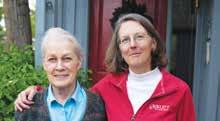
3 minute read
Homesharing
With the sharing economy now in full swing, sharing is not just caring; it is decidedly trendy. It is no surprise that the sharing economy is now making its way into the senior living industry.
A system in which people share goods and services in exchange for money, the most obvious example of a sharing economy is Uber, which allows riders to pay drivers for transportation. For seniors, the sharing economy now presents the opportunity to share their homes and earn extra money (or find affordable rent), enjoy compatible roommates and avoid isolation. Enter homesharing.
What is Homesharing?
Homesharing is when older adults rent extra rooms in their homes to compatible housemates to supplement their income. Renters get an affordable place to live. Everyone gets more social contact.
Depending on the type of homesharing arrangement, renters may provide light help around the house in exchange for lower rent. They may mow the lawn, take out the trash, clean the house or provide rides to the grocery store. This arrangement can make living independently easier for older adults—and allow them to remain in their homes longer.
How Do Homeowners Find Roommates?
Older adults may find roommates using existing connections. Anyone interested in homesharing should first talk to friends and family members. This simple act may lead homeowners to their very own roommate. It worked for the Golden Girls!
Seniors homeowners can also quickly and easily find roommates using online platforms. These platforms are specially designed to match homeowners with potential renters and are safe and easy to use.
One platform that particularly caters to seniors, baby boomers, empty nesters and other older adults is Silvernest. Silvernest uses a proprietary matching tool to help older adults find the perfect roommate. The platform also features resources including ID verification, background screening, electronic rent payments and lease generation.
How Do Renters Find Homes to Share?
Potential renters should also inform their friends and family that they are looking for a room to rent—and that they are open to living with an older adult. Renters can also use online sharing platforms to find available rooms in their area by searching based on their location and budget.
While Silvernest caters to homeowners who are 50+, the platform can help anyone find a rental property. Silvernest renters range in age from 20s to 80s. The platform also includes secure messaging, so potential housemates can learn more about one another and determine the homesharing arrangement that works best for them.
Independent Together
Sandy and Kathy are independent women. Sandy, 83, is an artist, gardener and yoga enthusiast. Kathy, 63, is an avid cyclist and hiker.
The two Fort Collins, Colorado, residents met through Silvernest, an online platform that matches older adults with roommates.
Sandy owns a home and had extra space for a roommate. “I was putting flyers out in churches and doing all kinds of things looking for a roommate, and Silvernest was really easy,” recalled Sandy.
Sandy was connected with Kathy via Silvernest, and the two hit it off quickly. The women spend time together playing cards, walking Sandy’s dog, and sharing a glass of wine. They both benefit from the built-in social interaction that homesharing offers.
“Social isolation is one of the biggest problems as people get old, and it is a big factor in dementia and everything else,” Kathy said. “I think having a roommate or housemate situation alleviates so much of that.”
Both women also benefit financially from the homesharing arrangement. Sandy gains extra income every month, and Kathy enjoys substantially lower rent. “I can have that money to go and travel or do things around town—or buy a bike,” Kathy noted.
Sandy enjoys having someone around to help with small tasks. Kathy helps Sandy with her dog and cat and is available to watch her beloved pets if she is out of town. Kathy also frequently carries heavy items up and down the stairs— making life a little easier for Sandy.
Sandy and Kathy are both healthy and independent—and they intend to stay that way—together.










